I've found that the most effective strategy is actually very simple. I've personally tested it, and the success rate is as high as 90% (Four-Step Strategy + Three Don'ts + Six Rules). It's simple and practical! I'm sharing it with everyone:
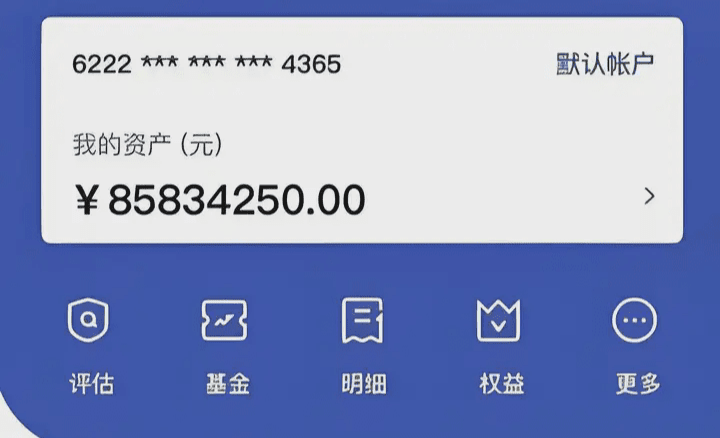
Step One: Choose the right coins
Open the daily chart and look at the MACD indicator first. Only select coins with gold cross signals (the MACD line crosses the signal line from bottom to top), especially those with gold crosses above the 0 axis. These signals are more successful. Simply put, this is the "buy signal flare" given by the market.
Step Two: Determine Buying and Selling with Moving Averages
Keep an eye on a moving average - the daily moving average (such as the 20-day moving average). There are only two sentences in the rules:
Hold online: When the price is above the moving average, hold with confidence;
Sell immediately offline: Once it falls below the moving average, clear the position immediately without hesitation.
This line is your "seat belt". Stop the loss if it falls below it. It's simple, crude, but effective.
Step Three: Position Management
Adding to positions: If the price breaks through the moving average and the trading volume also increases synchronously and stabilizes above the moving average, consider adding to your position.
Sell in batches:
Up 40%: Sell 1/3 first;
Up 80%: Sell another 1/3;
Breaks moving average: Sell all the rest.
This can lock in profits and avoid being trapped.
Step Four: Stop Loss Iron Law
The moving average is the core. If it suddenly falls below the moving average the next day, the position must be cleared immediately. Even if the selected coin is good, falling below the moving average means the trend has changed. Don't be stubborn and carry it. Wait for it to stabilize above the moving average again.
Three Don'ts Principles: Avoid Common Pitfalls
Don't chase the highs.
Don't rush in when everyone is snapping up, but calmly observe when everyone is panicking. For example, when the price of a coin falls, but the indicators start to improve, it may be an opportunity.Don't put all your eggs in one basket.
Diversify your funds into different coins, and don't put all your eggs in one basket. For example, divide it into 5 parts and invest only one part each time, so that the loss from a single mistake is controllable.Don't operate with a full position.
Keep some spare money to deal with emergencies. There are opportunities in the market every day, so there is no need to bet all at once.
Six Short-Term Trading Rules: Summary of Practical Experience
High-level consolidation may create a new high; low-level consolidation may create a new low.
Wait for the direction to be clear before taking action. Don't rush to enter the market.Don't move randomly when trading sideways.
Most people lose money because they can't help but trade at this time. Sideways trading means the market is "holding back big moves", wait patiently for the signal.Buy on bearish candles, sell on bullish candles.
Consider buying when the daily line closes bearish and selling when it closes bullish. It is often safer to go against short-term fluctuations.The slower the fall, the weaker the rebound; the more severe the fall, the stronger the rebound.
Adjust your strategy flexibly based on the speed of the fall to determine the strength of the rebound.Buy in batches to reduce risk.
For example, buy 10% for the first time, add another 10% if it rises by 5%, and so on. In this way, the cost is averaged and the risk is also diversified.The rise and fall will definitely trade sideways.
After a continuous rise or fall, it usually enters sideways consolidation. Don't sell all at the high and don't buy all at the low. Wait for the signal before taking action.
Summary: Steady and stable is the key.
Remember:
Don't be led by emotions: operate strictly according to the rules, and don't be confused by the impulse of "wait a little longer", "buy the dip", and "chase the rise".
Make small profits constantly: accumulate small profits through batch buying and selling and moving average stop loss, and grow slowly with compound interest.
Leave room for maneuver: Only by diversifying funds and not betting on one thing can you survive longer and earn longer in the market.
There is no shortage of opportunities in the cryptocurrency world. What is lacking is calmness and patience. Use simple strategies to filter out noise and focus on the trend. In the long run, making money steadily is more reliable than "getting rich overnight."

Even if you are a complete novice in the circle, you can easily make money as long as you strictly follow this method.
First, we need to set three moving averages on the candlestick chart*: the 5-day moving average, the 15-day moving average, and the 30-day moving average. The 30-day moving average is the lifeline and a strong support or resistance. Then you can buy and sell the coins through these three moving averages.
1. The selected coin must be in an upward trend. Of course, it is also possible to be in a consolidation, but it must not be selected if it is in a downward trend or the moving average is opening downward.
2. Divide the funds into three equal parts. When the price breaks through the 5-day moving average, buy 30% of the position lightly. When the price breaks through the 15-day moving average, buy another 30%. Similarly, buy the last 30% when it breaks through the 30-day moving average. This requirement must be strictly implemented.
3. If the price fails to break above the 15-day moving average after breaking the 5-day moving average and instead retraces, hold the original position as long as the retracement does not break the 5-day moving average. Sell if it breaks.
4. Similarly, if the price breaks above the 15-day moving average but does not continue to break upward, hold the position if the retracement does not break the 15-day moving average. If it breaks, sell 30% first. If it does not break the 5-day moving average, hold the remaining 30% of the 5-day moving average.
5. When the price continues to break through the 30-day moving average upward and retraces, throw it out once according to the previous method.
6. Exiting positions is the opposite. When the price is high, sell 30% first if it breaks the 5-day moving average. If it doesn't continue to fall, hold the remaining 60%. If the 5-day, 15-day, and 30-day moving averages are all broken, sell everything and don't be greedy.
Although this "fool-style" operation method is simple, the most important thing is to have execution. After you buy in, the buying and selling system is formed. Only by strictly following the trading discipline can you earn profits.
A set of stable compound interest strategies for cryptocurrency trading: (Harami pattern) has a success rate of up to 90%. Once you learn it, making money in the cryptocurrency world is as simple as breathing!
Without further ado, let's get straight to the point!
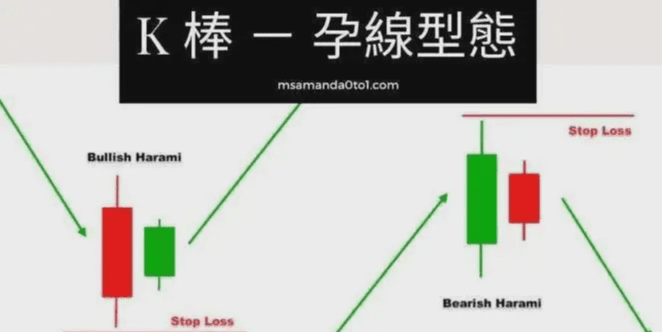
What is a Harami Pattern?
The harami pattern consists of two candlesticks. The first candlestick has a longer body and can be a bearish candle or a bullish candle.
The body of the latter candlestick should be shorter than the body of the former candlestick, and the highest and lowest prices of the latter candlestick are within the highest and lowest prices of the former candlestick.
From the graph, the latter candlestick looks like a fetus in the arms of a long candlestick, so it is figuratively called a "Harami", also known as a mother-child line. The harami pattern is exactly the opposite of the engulfing pattern, and the order of the two candlesticks is reversed. The color of the 「Harami」 candlestick can be opposite or the same, this is not important. The key is its location. The harami pattern, is the source of life, and it can also be a source of crisis. It means that the market has entered a consolidation, the volume has weakened, the trend is paused, there is no direction, the long and short sides are unclear, and the mood is hesitant. The follow-up can only be a trend continuation or a reversal. The harami combination is a typical trend reversal warning. The Harami combination follows which side breaks through to do which side, and the stop loss is placed in the middle. No matter whether it is the bulls or the bears, they are definitely not eternal. If the bulls have the upper hand, join the bulls' team, and if the bears are powerful, join the bears' ranks. Characteristics of the Harami Pattern
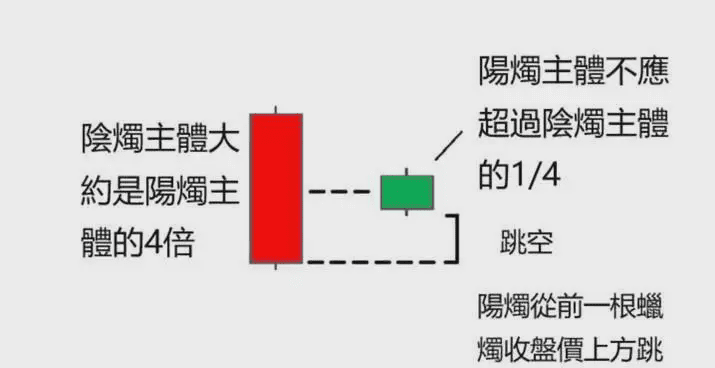
There must be a reasonably clear trend before the long body of this pattern.
A small body follows the long body, and the small body is completely contained within the body area of the long body.
The color of the long body on the first day reflects the direction of the market trend. A bearish candle reflects a downward trend, and a bullish candle reflects an upward trend. (The second body's color is opposite to the first one's color)
The smaller the body of the candlestick on the second day, the greater the reversal power of the entire pattern, which has a greater impact on short-term prices.
Doji Harami, that is, the candlestick on the second day is a doji line. When this pattern appears at the top or bottom of the market, the willingness to reverse is stronger. Effective/Ineffective Demonstration Chart
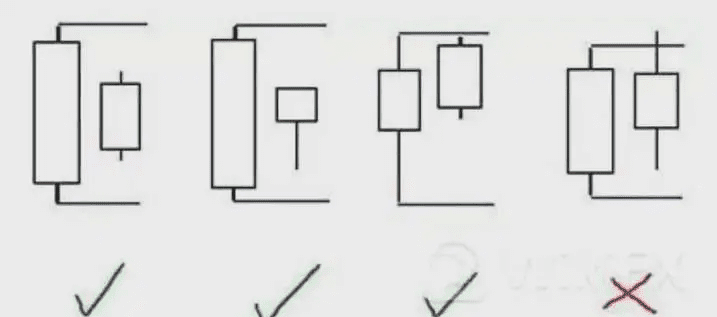
The picture above is a demonstration of effective and ineffective Harami midlines. Example
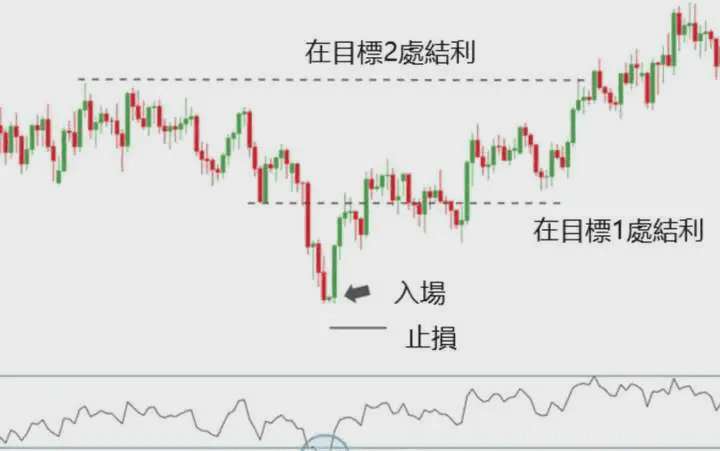
There is a clear downward trend.
A bullish hammer pattern appeared before the bullish harami, providing the first clue that the market might be about to reverse.
The length of the bullish candle does not exceed 25% of the previous candle.
The bullish candle opens and closes within the body of the previous candle.
RSI provides a signal that the market is oversold. This may mean that the downward momentum is bottoming out, but traders should wait for RSI to move back above 30 to confirm.
Identify bearish harami patterns, conditions are the opposite of bullish harami patterns.
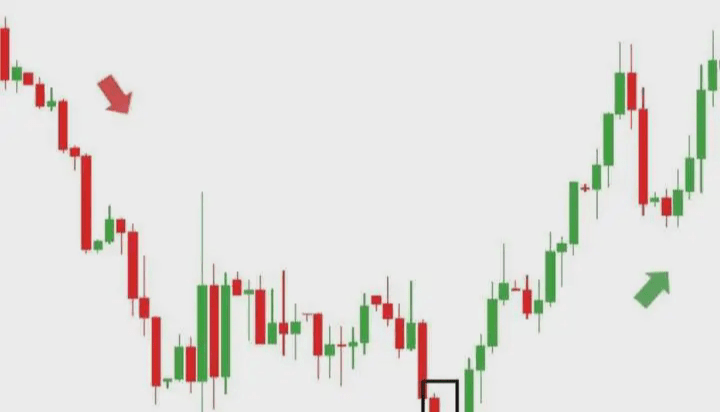
The best Harami midline signal is a breakthrough in the direction of the original trend. It is usually regarded as a relay pattern. If the Harami signal appears at a key support resistance position, it can be used as a signal that the price is running stagnant. In a few cases, it can also be used as a reversal signal. The closing direction of the Harami usually gives a good hint of the direction in which the market will break through. Those Harami midline signals with larger entities and smooth heads and feet are more effective. The standard Harami signal entry setting is to go long at the high point of the Harami in the direction of the trend, and the stop loss is placed at the low point. Bullish Cross Harami
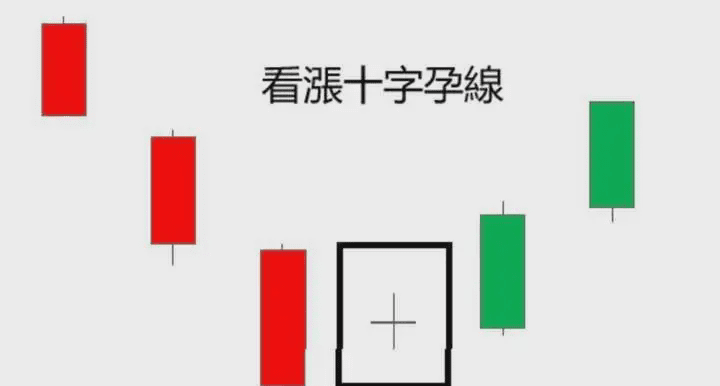
Traders often observe whether the second candle in the pattern is a doji. The reason is that the doji shows market indecision. The color of the doji candle (black, green, red) is not very important, because the doji itself appears near the bottom of the downtrend and provides a bullish signal. The bullish doji harami also offers an attractive risk-reward ratio because once confirmed, the upward move has only just begun. Bearish Harami

Multiple variations of Harami: Compared to engulfing patterns, the visual presentation of harami patterns is much more complex, with many 'variations' in form.
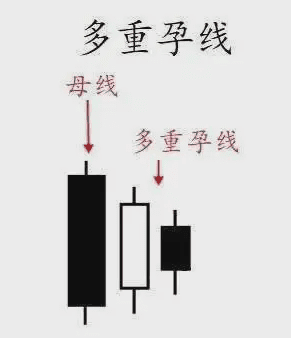
When two or more Harami patterns appear superimposed, that is, each candlestick is completely covered by the previous candlestick, this is a more powerful pattern than a single Harami because after the price completes stable and continuous consolidation, it will accumulate strong breakthrough momentum.
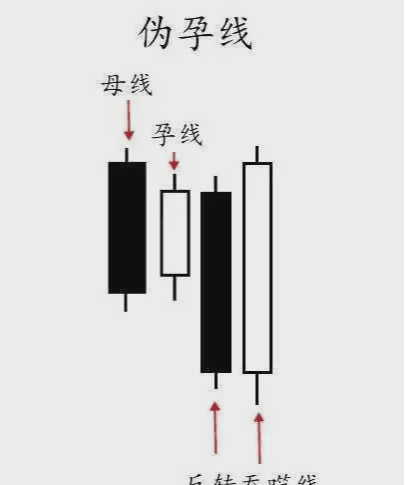
As shown in the figure, this is a combination of a harami combination and an engulfing line - although the potential reversal of the harami combination is eliminated by the third longer candlestick, a decisive reversal signal that engulfs the third candlestick eventually appears, and the trend reversal will be more powerful this time.
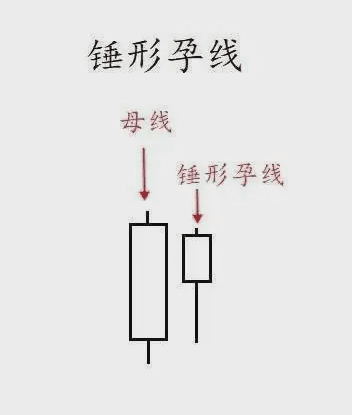
If the second candlestick is a doji or a shorter hammer line in the same direction as the first candlestick, it indicates a secondary effort by the bulls, but they still fail to surpass the previous high, resulting in a lower high for the candlestick body. Considering that any failed breakout tends to push the market in the opposite direction, this is a stronger reversal signal than a traditional harami. Limitations of the Harami Pattern: It should not be traded solely based on its formation; the location of the pattern within a trend is crucial; it must appear at the bottom of a downtrend.
It is necessary to understand some supportive technical analysis or indicators, such as the popular stochastic oscillator and RSI.

After trading for more than 10 years, I can now lie down and make stable profits, all thanks to realizing these 15 points.
My trading profit situation is quite stable, and novices often come to me to ask about trading methods. I am very willing to share my experiences over the years with everyone. Trading is an area that really requires hands-on experience to achieve true growth. With the right guidance, we can avoid detours and save time and energy.
Trading techniques are relatively easy to learn, and related materials can be found online or in trading courses. However, what is truly tested is the individual's trading mindset. The following 15 trading experiences that I am going to share have been guiding me in the right trading direction.
These experiences were gathered from my own trading and have been critical in developing the right trading mindset. By sharing these, I hope to help new traders or those already battling in the market achieve better trading performance and reduce unnecessary worries.
1. Be a very defensively-minded trader.
Becoming a very defensively-minded trader is a key transition for novice traders in their trading journey. Many novices may be confused by the mentality of seeking quick success at the beginning. They hope to make profits as soon as possible and even trade with the mentality of "getting rich overnight". However, a more practical and feasible mentality should be: protect your funds to the greatest extent. These two mindsets cannot coexist. If you only focus on making profits quickly, your funds may be lost faster.
A rule of the sports arena also applies to trading: offense is the best defense. In this context, it means only trading under favorable conditions and protecting funds away from the market at other times. Novices may be lucky enough to succeed in the first few trades, but luck cannot last and you should be wary of the "novice effect" trap.
Imagine, if you have a gun in your hand, you will not easily waste bullets unless you are absolutely sure that you can accurately hit your prey. The same principle also applies to trading. Keep your financial strength and only give a "fatal blow" when a truly favorable opportunity arises. In trading, protecting funds to the greatest extent is the key to success. As long as you can effectively control risks, even if you encounter a strong entry signal but ultimately fail, the impact on funds will be controlled within a reasonable range.
2. Frequent chart checking and constant monitoring of trades.
This often has an adverse effect on trading. In life, too much interference usually does not have good results. If you always try to over-control your trading, the results may be counterproductive and bring you more trouble.
Have you ever unconsciously added to your position or exited a trade early because you were too focused on the chart? Looking back, did you feel like you were too impulsive at the time? This unplanned behavior is often one of the reasons why many people lose money.
The easiest way is to set up a trading plan and then forget it. This is a principle that I often emphasize to beginners, and it is also one of the most valuable experiences that I have gained myself: the less you interfere with trading, the better. Simply follow your trading plan and let the transaction proceed according to plan, which is the real trading wisdom.
3. The results of the previous transaction should not affect the next transaction.
The results of the previous transaction should not affect the next transaction. This is an extremely important principle, but many people often forget it. They are easily swayed by the results of the previous transaction. However, it is necessary to understand that each transaction is unique and that the transaction results are randomly distributed. Suppose you make 100 transactions, the profits and losses may be similar. However, their distribution cannot be so uniform. It is possible that 5 or 10 consecutive losses will occur. If these losses affect your mentality, the profit opportunities that may arise next will also be hindered due to your emotional state.
It is equally important to note that overconfidence after a profitable trade can have the same negative impact on trading as the fear after a losing trade. Overconfidence can make people more willing to take on too much risk, and in the long run, the negative impact is quite terrible. Therefore, staying calm in trading and not being swayed by short-term trading results is the key to maintaining a stable mindset and achieving long-term success.
4. Simplify your trading, you will gain more.
In trading, moderation is key. A common mistake made by many traders is doing too much. They over-analyze the market, over-interpret the market, over-think, and over-order, and generally do many unnecessary things. As a trader, learning to be appropriately "lazy" is also important.
First, it's important to understand that the market presents a limited number of beneficial signals, and they may be rare. Most of what you see and hear may just be 'market interference,' noise that's not helpful. Learning to filter these signals and then select the 'high-quality signals' that are truly beneficial is a standard step in finding opportunities.
Second, I suggest you learn the mindset of hedge fund traders to trade. They hold millions of dollars or even hundreds of millions of dollars, but they trade very principled, like picking diamonds in the sand, only choosing the opportunities with the highest returns. For those ambiguous signals such as "maybe" and "seems", I advise you to stay away from them. In my 20 years of trading experience, the best trades are always the most obvious and straightforward.
5. Have a clear exit plan before entering the market.
In trading, no one tells you what to do. You have to make your own rules, which means you have to be responsible for your own actions. Many people lack this self-control, which often leads to losing their trading direction.
One of the most important tasks before trading is to determine your exit plan. It took me years to realize that exiting is more important than entering. I have observed that many people's exits are capricious, resulting in either very little profit or significant losses. Establishing a strict take-profit and stop-loss plan is the best way. Such a plan provides clear guidance, allowing you to stay calm and execute the plan, whether in profit or loss. This disciplined exit plan helps ensure that you keep a clear head and reduces the impact of impulse and emotions on your decisions.
6. Avoid worthless transactions.
In the world of trading, a worthless trade is one where the risk and reward are disproportionate. These usually occur when a trader is trading blindly and frequently. Such trades often lead to greater losses than profits, affecting the trader's mindset and even putting them into a vicious cycle of losses.
Specifically, traders are eager to enter the market when facing volatile markets and seeing so-called 'opportunities' without considering the profits and risks of the trade. These traders who blindly enter the market usually have a fluke mentality, thinking that even a small profit is profit. They turn a blind eye to small profits and see big risks, and even think that any market is an opportunity not to be missed, subjectively amplifying small opportunities and impulsively trading. This attitude not only shows contempt and disrespect for the market but also makes it difficult to achieve good results in the market.
For professional traders, they usually pre-formulate trading plans and set stop losses to ensure that even if they lose, the impact is not too great. However, the losses caused by worthless transactions are different because these traders have a shallow understanding of the market and make more casual trading decisions without careful consideration. This avoidable loss is more harmful than beneficial to the trader's growth.
7. High Discipline
A high degree of discipline plays a crucial role in financial market trading. It refers to a trader following a set of clear rules and principles when trading to ensure effective risk management, achieve investment goals, and avoid the adverse consequences of emotions and random decisions. The level of discipline is directly related to the success or failure of the trade and is considered to be a key factor in successful trading.
I insist on emphasizing not being influenced by emotions in trading decisions. I only spend half an hour a day looking at charts, deliberately avoiding getting caught up in excessive market observation. I recommend that traders strictly adhere to their trading plans and avoid over-analyzing the market because disciplined execution is the cornerstone of stable profits. By following a predetermined plan, I am able to remain calm and avoid emotional decisions, thereby improving the efficiency and stability of my trading.
8. Most of the time, you should stay away from the trading desk.
On the road of trading, a wise strategy is to stay away from the market. Overtrading is often a shortcut to losing funds, and it is important to remember this.
I strongly advocate using large time frames to examine market trends. This method is like a natural filter, which can eliminate many unnecessary information distractions. In this way, you can more focus on executing your trading plans to ensure efficient utilization of trading opportunities. In my opinion, the daily chart is the best choice for technical analysis.
9. Are you sleeping well at night?
The most direct way to understand your trading stress level is to do a sleep test.
If you risk too much on each trade, the trade becomes a nightmare that fills your mind. When you lie in bed, are you often troubled by trading worries? Do you wake up in the middle of the night and can't help but take out your computer or phone to check the market?
If you find yourself falling into these emotions, then there may be serious problems with your trading. Maintaining long-term trading and profitability requires effective risk management. If anxiety has affected your sleep, it means that the risk in your trading has exceeded the scope of what you can bear. It is essential to adjust your position and the investment in each transaction in a timely manner. Everyone should be cautious about this.
10. Before live trading, you have to do these two things.
Before engaging in live trading, there are two key points to keep in mind to ensure your trading doesn't become gambling.
First of all, you must have a clear trading strategy. In live trading, a lack of a trading strategy can easily lead you astray and lead to losses. It is best not to rush into trading until you have fully mastered your strategy. Remember, do not try to use multiple different trading methods at the same time, which will only make things more confusing.
Second, capital management is essential. Without enough capital, you will not be able to engage in trading for the long term, let alone make profits. Therefore, it is essential to deeply understand the importance of capital for trading. Do not waste your capital lightly, because it is the lifeline of your trading journey. Through effective capital management, you can better protect your investment and ensure that you can operate steadily in the market.
11. How is your self-control? This is very important.
The success or failure of trading depends not only on rational strategies, trading plans, and capital management, but also on psychological self-control. The trader's mentality can be said to be the leader of the trading rhythm, and successful traders must have extremely strong self-control.
In trading, the biggest challenge comes not from funding issues, but from fluctuations in personal emotions. A negative mentality can weaken the ability to respond to good trading opportunities and become the biggest trap in trading.
Letting emotional fluctuations run wild may lead to loss of reason and gradually erode the clarity of trading decisions. Confidence is the key to successful trading, but overconfidence can become a breeding ground for negative emotions.
In trading, a principled person can better master themselves and remain calm. Trading doesn't require excessive displays of personality; instead, it requires steady execution of plans and consistently rational decision-making. By building a solid psychological foundation, traders can better cope with market fluctuations and ensure a more stable and successful trading process.
12. The more favorable factors, the better.
The success of a trade depends on obtaining more favorable factors, as this will increase the likelihood of profit. In trading charts, if trend lines, key chart levels, and trading signals can remain consistent, the trade is more likely to be profitable.
Although many traders seek to avoid human error through automated trading systems, I personally don't like to rely on automated trading systems too much. I believe that as long as you can find the intersection of trends, water levels, and consistent signals, you can effectively execute transactions without worrying about the quality of the transaction. In trading decisions, unity and consistency are key, and this can be achieved by effectively integrating various supporting factors.
13. Do not add to losing positions.
In trading, focusing too much on win rates while neglecting risk management is a dangerous mindset. I insist that you should not add to losing positions because it turns trading into gambling. I believe that a successful trader should be risk-conscious and avoid taking chances, rather than seeking to double their account in the short term.
Some traders regard profit as a secondary goal and focus more on proving the correctness of their views. However, pursuing high win rates and neglecting risk management is an extremely dangerous attitude. When a trade goes wrong and is contrary to the market trend, some traders not only do not set stop losses and close positions but also continue to add to their positions, hoping that the market will reverse. This behavior makes the trade lose its rationality and is more like gambling. Successful traders should focus more on staying calm and controlling risks reasonably, rather than being blinded by short-term high win rates.
14. Set reasonable stop-loss orders and execute them strictly.
Ensuring reasonable stop-loss orders and executing them strictly is a crucial principle in trading. I have always believed that traders who do not set stop-loss orders may eventually face the risk of liquidation. In each order, set a reasonable stop-loss distance and make wise decisions based on individual circumstances. In addition, I would like to remind traders not to increase the stop-loss distance when losing or close the position too early when making profits.
After each trade is placed, stop-loss and profit targets should be set and kept away from emotional trading. Once set, it is best not to repeatedly check the order or chart, as such behavior may interfere with emotions. When you see an order losing money, it may induce traders to increase the stop-loss distance, resulting in greater losses. Conversely, when an order is profitable, closing the position too early may cause traders to miss more profits. In short, constantly staring at the market will have a great impact on emotions and mentality. The best thing to do is not to intervene too much after setting it up.
15. Wait patiently for the best trading opportunity.
If you find it difficult to endure this torment, waiting for a clear trend to emerge before taking action is also a good option. The market is never short of opportunities; what is truly lacking is a constantly prepared attitude. In the world of trading, waiting patiently and ensuring your mindset is at its best is the key to success. Do not rush to act, but wait for the right moment, because a clear trend will provide you with a clearer direction.
In trading, the market often generates false or weak signals; however, the importance of waiting for the best trading opportunity is self-evident, just like a cheetah waiting for the best prey. For weak signals, we should not be too adventurous but should patiently wait for conclusive opportunities. Patience is essential because the market is constantly fluctuating, but not every moment is the best trading opportunity.
Finally, one thing I need to emphasize is that trading is not everything in life. It is just a way of investing and should not affect your normal life. Unless you are a professional trader, do not put all your time into trading and should have your own work and career.
In conclusion, successful traders need to adhere to simple and effective trading strategies, maintain a high degree of discipline, wait for the best opportunities, set reasonable stop-loss orders, avoid over-trading and risk-taking, and not forget that there are other aspects of life and career outside of trading. These suggestions can help more people succeed in the financial markets.
Old Bo only does live trading, and the team still has positions to get on board quickly.


